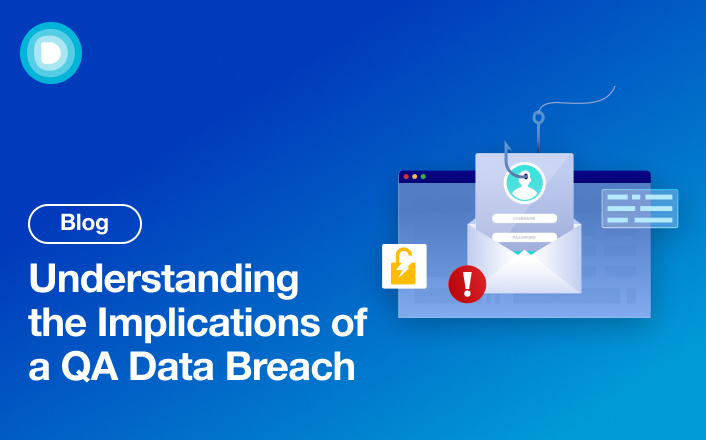- Product
-
Solution
-
By Industry
Cybersecurity solutions tailored to your industry’s needs.
-
- Resources
-
Books
Our ultimate guides and playbooks
Solution Briefs
Overview of PureDome’s functionality
-
Quizzes
Assess your cybersecurity readiness
Case Studies
PureDome customer success stories
Newsletter
Subscribe to the PureDome newsletter
-
- About Us
- Partner
- Pricing
- Download
Understanding the Implications of a QA Data Breach
-
Aiman Ikram
-
20 May 2024
- 3 min read


If you have ever wondered how the top performing apps and software stay glitch-free - Quality Assurance (QA) data is the answer. It's like the secret sauce behind the scenes, ensuring everything runs smoothly.
But here's the catch: this data isn't invincible. Hackers love to mess with it, putting our privacy at risk. In this blog, we are exploring why QA data is a target and how we can keep it safe.
What is a QA Data Breach?
A QA data breach occurs when unauthorized individuals gain access to the data used for Quality Assurance (QA) purposes, typically during the testing phase of software development. It harms the confidentiality of the QA data and causes its illegal use. This results in compromised user privacy, data manipulation, and damage to the reputation of the organization responsible for the software.
How Does a QA Data Breach Occur?
A QA data breach can happen in several ways:
Exploiting Vulnerabilities: Hackers may exploit weaknesses in software systems or networks to gain unauthorized access to QA data.
Insider Threats: Employees or contractors with access to QA data may intentionally or unintentionally expose it to unauthorized individuals.
Phishing Attacks: Hackers may use deceptive emails or messages to trick employees into providing access credentials, allowing them to infiltrate QA systems.
Insecure Storage: Storing QA data in inadequately protected databases or cloud services can make it vulnerable to unauthorized access.
Inadequate Security Measures: Failure to implement robust security measures, such as encryption and access controls, can leave QA data susceptible to breaches.
Third-Party Risks: Sharing QA data with third-party vendors or partners without proper security measures can increase the risk of breaches if these entities are compromised.
What Sensitive Information is at Risk in a QA Data Breach?
In a QA data breach, personal user data (like names and addresses), login details, financial information, and private business data are all vulnerable. This includes info used during testing, such as sample user inputs or simulated transactions, which help check if the software works correctly. If the breach involves data from live systems, it could expose even more sensitive info, like real user data or confidential business records.
Impact of QA Data Breaches on Businesses
QA data breaches can seriously hurt businesses. First, they make customers lose trust, which can mean fewer customers and a bad reputation. Second, they can cost a lot of money because of fines, paying people affected, and fixing the problem.
Also, they can stop a business from working properly, causing them to lose time and money. They might get in trouble with the law for not keeping data safe. Overall, QA data breaches can mess up a business, making it lose money and trust from customers.
Best Practices for Securing QA Data
Implement Strong Access Controls
Restrict access to QA data to only authorized personnel. Utilize role-based access controls and least privilege principles to ensure individuals only have access to the data they need for their job.
Encrypt Data
Utilize encryption techniques to protect QA data both when it's being transferred between systems and when it's stored. This adds an extra layer of security, making it difficult for unauthorized parties to access sensitive information even if they manage to intercept it.
Regularly Update Security Measures
Stay vigilant and keep all software, systems, and security protocols updated with the latest patches and upgrades. Regular updates help to address any known vulnerabilities and strengthen defenses against emerging threats.
Train Employees
Provide comprehensive training to all staff members on security best practices. This includes raising awareness about phishing scams, password hygiene, and the importance of reporting any suspicious activity promptly. Well-informed employees are your first line of defense against cyber threats.
Implement Zero Trust Network Access (ZTNA)
Adopt a Zero Trust approach to network security, which assumes that threats could be both external and internal. ZTNA verifies every user and device attempting to access QA data, regardless of their location or whether they're accessing it from within the internal network.
This ensures that only authenticated and authorized users can access sensitive data, reducing the risk of insider threats and unauthorized access.

How PureDome Helps
PureDome helps businesses protect their QA data easily. It decides who gets to see the data, hides it with encryption, and spots any weird stuff happening right away. PureDome also watches how people use the data to catch any funny business. And it makes sure only the right folks can get to the data, no matter where they are.
Frequently Asked Questions
What is QA data?
QA data refers to the information generated during the testing phases of software development to ensure its quality and functionality.
How does a QA data breach occur?
A QA data breach can happen through vulnerabilities exploitation, insider threats, phishing attacks, insecure storage, or inadequate security measures.
How does PureDome help protect QA data?
PureDome protects QA data by controlling access, encrypting data, detecting suspicious activity, and ensuring that only authorized users can access sensitive information.